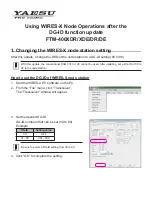
9
REAR-PANEL CONNECTIONS
AM and FM Antenna Terminals:
Connect the included AM and
FM antennas to their respective terminals for radio reception.
XM Antenna Jack:
Plug in an XM antenna module here. The XM
antenna module is purchased separately, and should specify that it is for
home use with an XM-Ready
®
product. You will need to subscribe to the
XM service, which is available separately, and activate the service for
your antenna module. (XM service is not available in Alaska and Hawaii.)
Front, Center and Surround Speaker Outputs:
Use two-con-
ductor speaker wire to connect each set of terminals to the correct
speaker. Remember to observe the correct polarity (positive and nega-
tive connections). Always connect the positive lead to the colored termi-
nal on the receiver and the red terminal on the speaker. Connect the
negative lead to the black terminal on both the receiver and the speaker.
See the Connections section for more information on connecting your
speakers.
Surround Back/Multiroom Speaker Outputs:
These speaker
outputs may be used either for the surround back channels in a 7.l-
channel home theater, or they may be reassigned to a remote room for
use with a multiroom system. When these outputs are reassigned for
multiroom operation, only a 5.1-channel configuration will be available in
the main listening room. Use the on-screen menu system to configure
these channels as desired.
As with the other speaker outputs, remember to observe proper polarity
by connecting the positive and negative output terminals to the corre-
sponding terminals on each speaker.
Subwoofer Output:
If you have a powered subwoofer, connect it to
this jack.
Preamp Outputs:
Connect these jacks to an external amplifier if
more power is desired.
Surround Back/Multiroom Preamp Outputs:
These outputs
may be used with an external amplifier either to power the surround
back channels, or to power the speakers in the remote zone of a multi-
channel system. Use the on-screen menu system to configure these
channels as desired.
Remote Infrared (IR) Input and Output:
When the remote IR
receiver on the front panel is blocked, such as when the AVR is placed
inside a cabinet, connect an optional IR receiver to the Remote IR Input
jack for use with the remote control. The Remote IR Output may be
connected to the Remote IR Input of a compatible source device (or
other product) to enable remote control through the AVR. This is particu-
larly useful in multiroom applications, when you wish to control the
source device from the remote room (when used with the Multiroom IR
Input). When several source devices are used, connect them in “daisy
chain” fashion.
Multiroom Infrared (IR) Input:
Connect a remote IR receiver
located in the remote zone of a multiroom system to this jack to control
the AVR and any source devices connected to the Remote IR Output
from the remote zone.
Video 1, Video 2, Video 3 and DVD Audio/Video Inputs:
These jacks may be used to connect your video-capable source
components (e.g., VCR, DVD player, cable TV box) to the receiver.
Remember to use only one type of video connection for each source.
See the Connections section for more information on audio and video
connection options for each source component.
Video 1 Audio/Video Outputs:
These jacks may be used to
connect your VCR or another recorder.
Composite and S-Video Monitor Outputs:
If any of your
sources use composite or S-video connections, you may need to
connect one or both of these monitor outputs to the corresponding
inputs on your television or video display in order to view the sources
and to view the on-screen displays. If your video display is equipped
with component video inputs, you may take advantage of the AVR 245’s
transcoding capability, which transcodes composite and S-video signals
to component video, allowing for only a single video connection from
the AVR to the video display. However, the on-screen displays are not
available using component video.
HDMI Inputs and Output:
HDMI (High-Definition Multimedia
Interface) is a newer type of connection for transmitting digital audio and
video signals between devices. Although the AVR 245 is not capable of
processing HDMI signals, if your video display is HDMI-capable, you may
connect up to two HDMI sources here, and then connect the HDMI out-
put to your video display for improved video performance. It is recom-
mended that you disable the HDMI audio function of your video display,
and make a separate digital audio connection from the source device to
one of the AVR’s coaxial or optical digital audio inputs to benefit from
the AVR 245’s multichannel audio processing.
The AVR 245 will not convert other types of video to HDMI, and you will
not be able to view the on-screen displays using the HDMI connection.
CD and Tape Audio Inputs:
These jacks may be used to connect
audio-only source components (e.g., CD player, tape deck). Do not con-
nect a turntable to these jacks without a phono preamp.
Tape Outputs:
These jacks may be used to connect a CDR or
another audio-only recorder.
Coaxial and Optical Digital Audio Inputs:
If a source has a
compatible digital audio output, connect it to one of these jacks for
improved audio performance. Remember to use only one type of digital
audio connection for each source.
Coaxial and Optical Digital Audio Outputs:
If a source is also
an audio recorder, you may connect a compatible digital audio output to
the recorder’s input for improved recording quality.
The Bridge/DMP Input:
Connect the optional Harman Kardon
to this input for use with your iPod (not included). Make
sure the receiver is turned off (in Standby mode) when connecting
The Bridge.
The
Bridge
TM
HKP1477AVR245om 8/29/06 5:45 PM Page 9
Содержание AVR 245
Страница 1: ... Designed to Entertain AVR 245 AUDIO VIDEO RECEIVER OWNER S MANUAL ...
Страница 75: ...NOTES ...










































